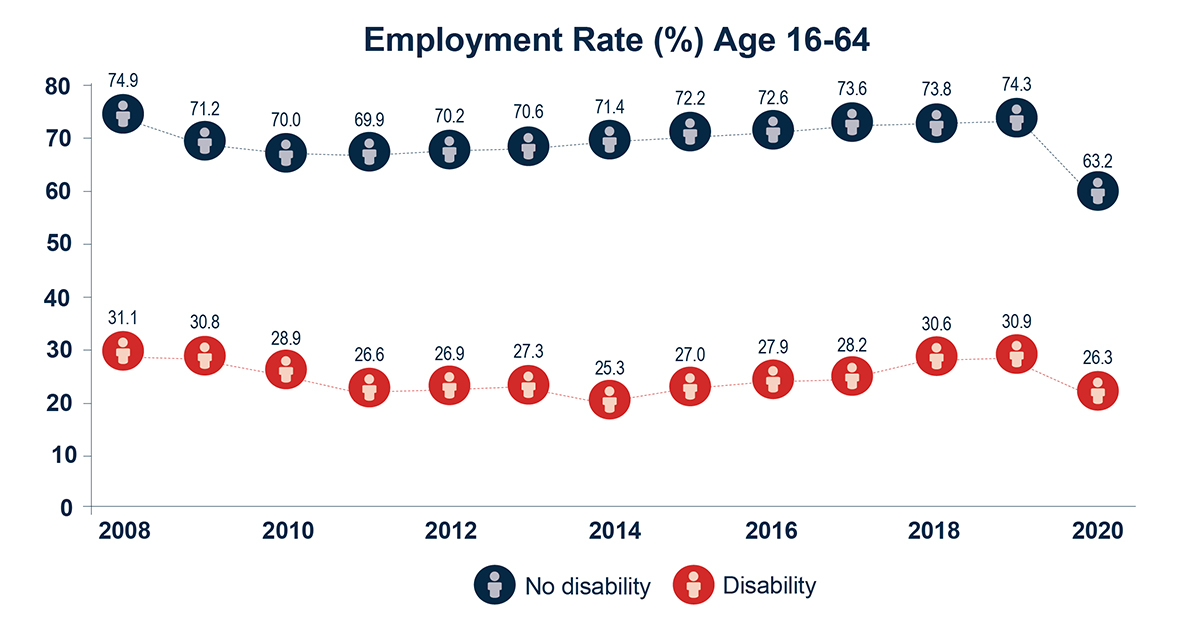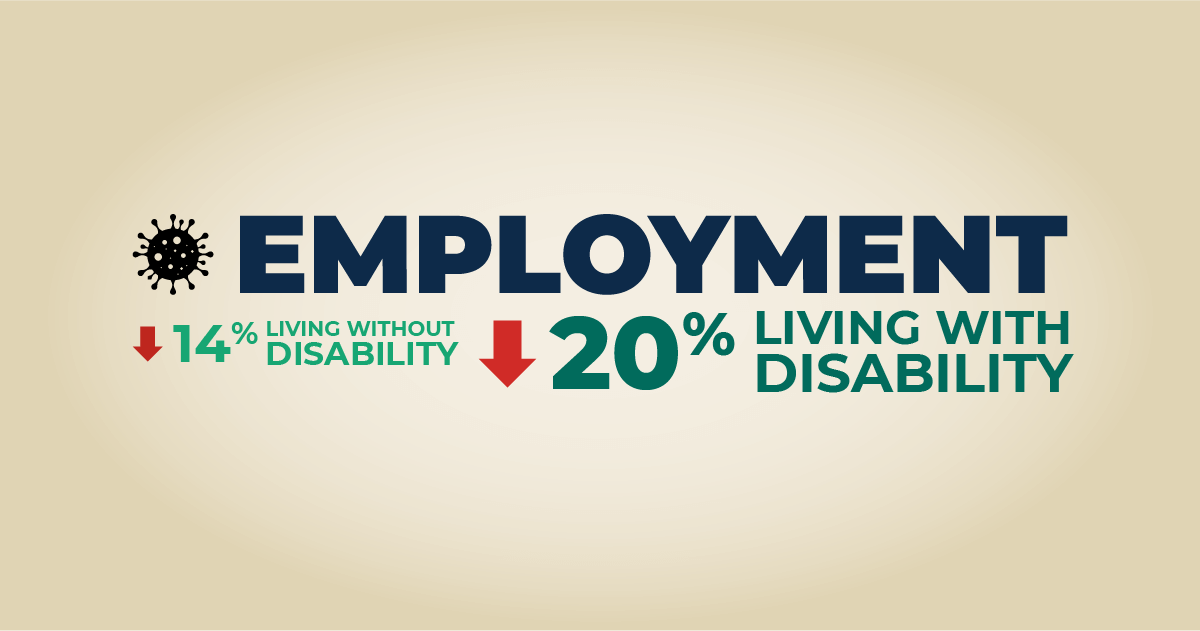Measures taken in response to the COVID-19 pandemic in the United States have had sudden and profound effects on the labor market, with millions of American workers being laid off since March 2020. The national unemployment rate increased from 3.5 percent in February 2020 to 14.7 percent in April 2020, the highest rate since the Great Depression in the 1930s. Experts believe that the sudden and dramatic effects of the pandemic on the economy have begun a recession in the United States and globally.
Workers with disabilities represent only about 3 percent of the labor force, but they have experienced disproportionate labor market impacts of the COVID-19 pandemic. These impacts are important to monitor because even in less trying times, many workers and job seekers with disabilities face significant challenges to employment related to health and functioning, accessible workplaces and transportation, accommodations, and discrimination. As a result, the employment rate of people with disabilities is persistently less than half that of their nondisabled peers, and their unemployment rate is more than twice as high.
Since March, workers with disabilities have lost nearly one million jobs, representing a 20‑percent decline compared with the 14-percent decline experienced by workers without disabilities. We do not yet know what the economic recovery will look like as businesses reopen after COVID-19 closures, but we can look to the recent economic downturn of the Great Recession, which officially lasted from December 2007 to June 2009, for some possibilities. During the Great Recession, the employment rate fell more for people with disabilities than it did for people without disabilities, and the rate continued to fall after the recession officially ended.

Source: U.S. Bureau of Labor Statistics. Data are from the Current Population Survey and represent the percentage of the civilian population ages 16 to 64 that were employed in April of each year shown except 2008. The 2008 statistic shown is for June, the first month for which data on people with disabilities is available.
Together with increased unemployment, past recessions also saw increased applications for Social Security Disability Insurance (SSDI) benefits. During the Great Recession, SSDI applications increased by 28 percent, and about one-quarter of this historically large increase was attributable to the recession. A large share of these applications was successful, suggesting that many workers with disabilities left the labor force prematurely and permanently because of the recession. Relatively few people who enter the SSDI program return to work at levels that allow them to leave benefits, meaning that recession-induced SSDI entry is costly in terms of federal government expenditures, productivity losses to the country, and the quality of life for many who are worse off economically after entering SSDI.
Of course, the circumstances of the COVID-19 economic downturn differ substantially from those of earlier recessions, and those differences combined with a strong labor market for people with disabilities before the pandemic might signal that a different recovery is possible. Potential outcomes include the following:
- The pandemic has caused more profound, unforeseeable, and widespread job loss than occurred during the Great Recession, but the recovery could be faster if most job losses are temporary. Yet people with disabilities who have health conditions that compromise their immune systems might not want to return to jobs that do not allow them to limit their proximity to others, which could delay the recovery for this group.
- The pandemic has led to businesses finding ways to continue operations with their staff working from home and, often, with more flexible hours to permit workers to care for children who are unable to attend school or day care. If, because of the experience during the pandemic, more businesses offer flexible hours and telework options in the future, this could create more job opportunities for people with disabilities who have impairments that make it difficult to work outside the home or who require more flexibility in their work schedules. Many firms will be struggling financially, however, and focused on resuming basic operations, and they might have less capacity to provide accommodations or customize jobs for workers with disabilities.
- The Coronavirus Aid, Relief, and Economic Security Act, or the CARES Act, expanded unemployment insurance in terms of duration (through the end of 2020), generosity (a temporarily increased weekly benefit amount), and the number of workers covered. Notably, unemployment insurance under the CARES Act is now available to independent contractors in many states. Although unemployment insurance was extended during the Great Recession, the other changes might mean that a larger share of workers with disabilities will rely on unemployment insurance to weather the economic storm without detaching from the labor market. In turn, this could signal delayed or reduced SSDI entry.
The impacts of COVID-19 are still unfolding, and predicting the economic recovery is impossible in these unprecedented times. The experience of the Great Recession suggests that workers with disabilities are likely to be harder hit, and some could permanently withdraw from the labor force and rely on federal programs for income support and health care. Yet, to the extent that the COVID-19 experience spurs employers to be more creative in providing accommodations and other supports, workers with disabilities might benefit moving forward.




